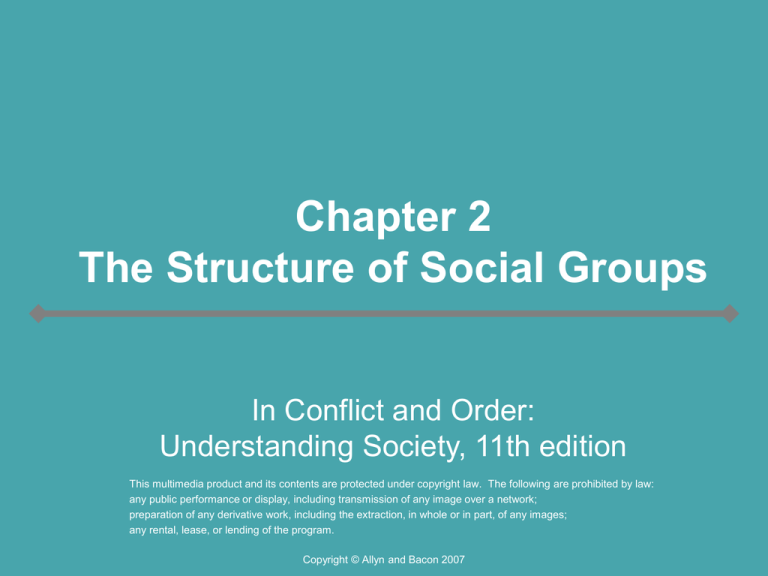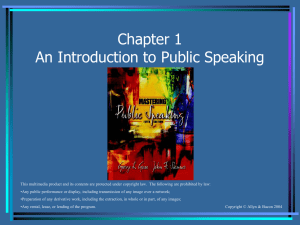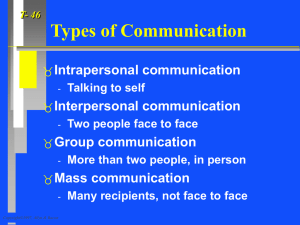Chapter 2 The Structure of Social Groups
advertisement

Chapter 2 The Structure of Social Groups In Conflict and Order: Understanding Society, 11th edition This multimedia product and its contents are protected under copyright law. The following are prohibited by law: any public performance or display, including transmission of any image over a network; preparation of any derivative work, including the extraction, in whole or in part, of any images; any rental, lease, or lending of the program. Copyright © Allyn and Bacon 2007 The Micro Level • Social Organization – The ways in which the human conduct becomes socially organized • Social conditions that constrain behavior: – Social Structure • The structure of behavior in groups and society – Culture • The shared beliefs of group members that unite them and guide behavior Copyright © Allyn and Bacon 2007 The Micro Level • Social Interaction – When the actions of one person affect another person – The most common method is through speech – Enduring social interaction is a social relationship Copyright © Allyn and Bacon 2007 The Micro Level • Culture – The shared beliefs of a group’s members that serve to guide conduct – Common expectation about how people should act are called norms – Criteria for judging what is appropriate, correct, moral and important are the values of a group – The expectations that group members have of individuals occupying the various positions within the group are social roles Copyright © Allyn and Bacon 2007 The Micro Level • Norms – Rules that specify appropriate and inappropriate behaviors • Folkways are minor rules • Mores are important norms • Status – The positions each societal member occupies – A master status is a status that has exceptional significance for social identity. Copyright © Allyn and Bacon 2007 The Micro Level • Role – The behavioral expectations and requirements attached to a position in a social organization • Reasons for varied behavior within a role – Personality variables can account for variations in the behavior of people holding identical statuses – The occupants of a status may not receive a clear, consistent message about which behavior is expected – The statuses we occupy may have conflicting demands on our behavior due to multiple group memberships Copyright © Allyn and Bacon 2007 The Micro Level • Social Control – Social groups universally demand conformity to some norms. – Mechanisms of social control can occur subtly in the socialization process, in the form of rewards, or can be public. – Sanctions are social rewards or punishments for approved or disapproved behavior. Copyright © Allyn and Bacon 2007 Primary and Social Groups • Social Group – An organization created through enduring and patterned interaction • Primary Group – Groups whose members are most intimately involved with each other • Secondary Group – Formally organized, task oriented, and relatively nonpermanent groups Copyright © Allyn and Bacon 2007 Bureaucracy: The Ultimate Social Group • A bureaucracy is a hierarchical formal organization characterized by rationality and efficiency • The increasing bureaucratization of social life is called McDonaldization, as coined by George Ritzer. • There is the danger that Max Weber feared from the “iron cage” of rationality. Copyright © Allyn and Bacon 2007 Power of the Social Group • The Group Affects the Probability of Suicide – Emile Durkheim’s Suicide • One’s attachment to social groups affects the probability of suicide. • Types of Suicide – Egoistic suicide – Altruistic suicide – Anomic suicide Copyright © Allyn and Bacon 2007 Power of the Social Group • The Group Affects Perceptions – Apparently, our wish to conform is so great that we often give in to group pressure. • The Group Affects Convictions – Sectarians with group support maintain their conviction despite contrary evidence. • The Group Affects Health and Life – Membership in a group may have an effect on one’s health and even on life itself. • The Group Affects Behavior – The group can alter the behavior of members, even behaviors that involve basic human drives. Copyright © Allyn and Bacon 2007 Figure 2.1 – Process of Social Organization Source: This scheme is adapted from that developed by Marvin E. Olsen, The Process of Social Organization, 2nd ed. (New York: Holt, Rinehart and Winston, 1976) Copyright © Allyn and Bacon 2007 The Societal or Macro Level • Society – An aggregate of people, united by a common culture, who are relatively autonomous and self-sufficient and who live in a definite geographical location Copyright © Allyn and Bacon 2007 Society as a Social System • Society is a social system composed of interdependent parts that are linked together into a boundary-maintaining whole. • Culture explains much individual and group behavior as well as the persistence of much of social life. • Social Stratification is the hierarchical arrangement of people in terms of power, prestige, and resources. • Social Institutions are social arrangements that channel behavior in prescribed ways in the important areas of social life. Copyright © Allyn and Bacon 2007 Copyright © Allyn and Bacon 2007




